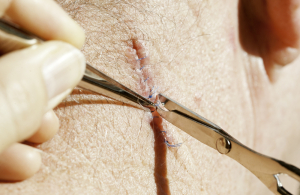In cosmetically sensitive areas such as the face skin excisions and scar revisions are done by plastic surgeons using various special techniques and they are trained to be extra cautious about the underlying anatomical structures.
First, there are vital nerves very close to the surface of the skin that could be injured, if a less experienced physician has to do a wide excision of a cancer. Secondly, plastic surgeons are well versed in the use of z-plasties, a technique where a scar can be moved, concealed and heal with a lot less scarring. However, there have been developments in this area, which allow the patient to achieve excellent results with minimal surgical intervention. This technique has been named “spacelift“. When we age, we lose subcutaneous fat under the skin of the face and elasticity of the skin. This leads to wrinkles and a hollow, sunken look of the face, which we interpret as “aged looking”. As this reference shows, the lost fat can be re-injected with fat that is harvested from the abdominal area. There is a fat harvesting step first where the fat is removed by liposuction. This harvested fat is separated into fat stem cells and fat cells with the help of a cell separator. Connective tissue is discarded. Fat and stem cells are re-injected into the areas of the face, where the cosmetic surgeon feels subcutaneous fat is missing. This is like sculpturing while the images of pictures of the younger looking patient are taken as a guidance. Should one or two spacelifts (typically 1 year in between) not give the desired result, you can still switch to conventional facelift procedures where excessive skin is taken off or sagging tissues are lifted up with help of a mini-face lift that plastic surgeons have been using all along.
Here is a link to a site, which gives more details and shows pictures before and after skin lesion excisions. Regarding the removal of keloid scars and other unsightly scars through plastic surgery, here is a link to show pictures before and after scar revision .
References:
1. Habif: Clinical Dermatology, 3rd ed.,1996, Mosby-Year Book, Inc.
2. The Merck Manual, 7th edition, by M. H. Beers et al., Whitehouse Station, N.J., 1999. Chapter 117.
3. Cotran: Robbins Pathologic Basis of Disease, 6th ed.,1999, W. B. Saunders Company
4. Noble: Textbook of Primary Care Medicine, 3rd ed., 2001, Mosby, Inc.
5. Rakel: Conn’s Current Therapy 2001, 53rd ed., 2001, W. B. Saunders Company
6. Goroll: Primary Care Medicine, 4th ed., 2000, Lippincott Williams & Wilkins
7. Richard J. Lewis, M.D. at the 42nd Annual St. Paul’s Hosp. CME Conf., Nov.1996, Vancouver/BC
8. Jerry Shapiro, Prof. Dermatol., UBC, at 45th Annual St. Paul’s Hosp. CME Conf., Nov.1999, Vancouver/BC
9. D Seager Int J Cosmet Surg Vol 6, No. 1, 1998: 27-31.
10. Townsend: Sabiston Textbook of Surgery, 16th ed.,2000, W. B. Saunders Company
11. Ferri: Ferri’s Clinical Advisor: Instant Diagnosis and Treatment, 2004 ed., Copyright © 2004 Mosby, Inc.
12. Rakel: Conn’s Current Therapy 2004, 56th ed., Copyright © 2004 Elsevier







